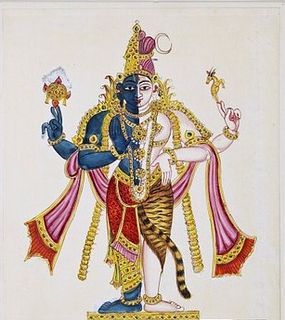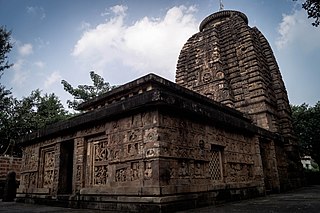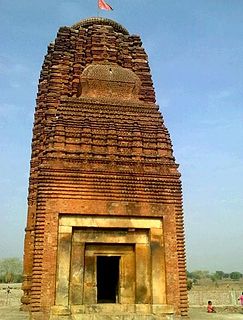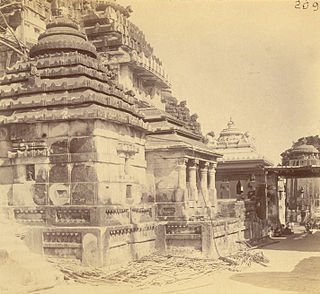
Jagannath is a deity worshipped in regional Hindu traditions in India and Bangladesh as part of a triad along with his brother Balabhadra and sister, devi Subhadra. Jagannath within Odia Hinduism is the supreme god, Purushottama, Para Brahman. To most Vaishnava Hindus, particularly the Krishnaites, Jagannath is an abstract representation of Krishna, and Mahavishnu, sometimes as the avatar of Krishna or Vishnu. To some Shaiva and Shakta Hindus, he is a symmetry-filled tantric form of Bhairava, a fierce manifestation of Shiva associated with annihilation.

Harihara is the fused sattvika characterisation of Vishnu (Hari) and Shiva (Hara) from Hindu theology and religion. Hari is the form of Vishnu, and Hara is the form of Shiva. Harihara is the also known as Shankaranarayana like Brahmanarayana (Half represents Brahma and half represents Vishnu), Harihara is thus revered by both Vaishnavites and Shaivites as a form of the Supreme God.

Lingaraja Temple is a Hindu temple dedicated to Shiva and is one of the oldest temples in Bhubaneswar, the capital of the Indian state of Odisha,India. The temple is the most prominent landmark of Bhubaneswar city and one of the major tourist attractions of the state.

Parsurameswara Temple also spelt Parashurameshvara, located in the East Indian city of Bhubaneswar, the capital of Odisha,India, is considered the best preserved specimen of an early Odia Hindu temple dated to the Shailodbhava period between the 7th and 8th centuries CE. The temple is dedicated to the Hindu god Shiva and is one of the oldest existing temples in the state. It is believed to have been built around 650 CE in Nagara style and has all the main features of the pre-10th century Kalinga Architecture style temples. The temple is one among the Parashurameshvara group of temples.

Siva dol is a group of structures comprising three Hindu temples of Sivadol, Vishnudol and Devidol shrines, and a museum. These are located on the banks of the Sivasagar tank, also known as the Borpukhuri tank, in the heart of Sivasagar, in the Indian state of Assam. The tank was constructed between 1731 and 1738 and the temples were built in 1734 by Bar Raja Ambika, queen of Ahom king Swargadeo Siba Singha (1714–1744). The height of the Sivadol is 104 feet (32 m) and the perimeter is 195 feet (59 m) at the base. It is crowned with an 8-foot (2.4 m) high golden-dome.
Bharmour, formally known as Brahmpura, was the ancient capital of Chamba district in Himachal Pradesh, India. Situated at an altitude of 7000 feet in the Budhil valley, forty miles to the south-east of Chamba, Bharmour is known for its scenic beauty and for its ancient temples. Some of the temples are believed to date from 10th century.

The Siddhesvara Temple is located in the town of Haveri in Haveri district, Karnataka state, India. It is considered an ornate example of 12th century Western Chalukyan art and is well known for the many loose sculptures of Hindu deities that exist in it. However, inscriptional evidence would suggest that the initial consecration of the temple was in late 11th century. An interesting aspect about the temple is that it faces west, instead of facing the rising sun in the east–a standard in Chalukyan constructions. Though it is currently used as a Shaiva temple dedicated to God Shiva, historians are unsure by which faith or sect the temple was originally consecrated and to which deity. This uncertainty perhaps stems from the many loose sculptures of deities that exist and the degradation of primary wall images.
Tourism in Odisha is one of the main contributors to the Economy of Odisha, India, with a 500 km (310 mi) long coastline, mountains, lakes, natural biodiversity and rivers. Odisha is one of the major tourism sectors of India, with various tourists' attractions, ranging from wildlife reserves, beaches, temples, monuments, the arts and festivals. Other than wildlife reserves, beaches, temples, monuments, the arts and festivals, the Odisha Tourism Development Corporation, a Public Sector Undertaking of Government of Odisha, is also developing tourism sector of Odisha and India.

Baitāḷa deuḷa or Vaitāḷa deuḷa is an 8th-century Hindu temple of the typical Khakara style of the Kalinga architecture dedicated to Goddess Chamunda located in Bhubaneswar, the capital city of Odisha, India. It is also locally known as Tini-mundia deula due to the three spires on top of it, a very distinct and unusual feature. The three spires are believed to represent the three powers of the goddess Chamunda - Mahasaraswati, Mahalakshmi and Mahakali.

Madhava Temple,, is the temple dedicated to Lord Vishnu. It is located at the Madhab village of Niali block in Cuttack district, Odisha.

Indralatha Temple is dedicated to Shiva and is situated in Bangomunda block near Ranipur-Jharial in Balangir district. It was supposed that Indra first worshipped lord Shiva here and erected a temple.
Bhuvaneshwar Temple is located in Malipara in the Boudh township of Odisha, India. On the left side of road leading from Boudh to Sonepur, it is situated on the right bank of Mahanadi. It can be assigned to 10th Century, during Somavamsi rule. Decorated with architectural motifs like – khakharamundis, divine figures like Ganesha and Jaina Tirthankaras, semi-divine figures, nayikas, image of Linga puja, human figures both male and female, bharabahaka, decorative motifs like scroll work, beaded border, lattice pattern, padmaprosta motifs, mohanty design, vajramundi, animals, mithuna and maithuna. Nataraja and Brahma idols are also found. It can be categorized as Rekha deula of South Kosalan style. Shivaratri, Shitalasasthi and all Purnimas are important days here.
Singhanath Temple is dedicated to Shiva who is worshipped by Narasimha, an avatar of Vishnu. The temple has a rekha deula and terraced roof jagamohana of traditional phase of temple style of Kalingan order. The temple is unique for its sculptural embellishment of both the Saivaite and Vaishnava sects. It is located in the Gopinathpur village, Baramba tehsil of Cuttack district,Odisha,India. It can be easily approached by road from Cuttack, Chaudwar and Athgarh.

The Kaḷinga architectural style is a style of Hindu architecture which flourished in the ancient Kalinga previously known as Utkal and in present eastern Indian state of Odisha. The style consists of three distinct types of temples: Rekha Deula, Pidha Deula and Khakhara Deula. The former two are associated with Vishnu, Surya and Shiva temples while the third is mainly with Chamunda and Durga temples. The Rekha Deula and Khakhara Deula houses are the sanctum sanctorum while the Pidha Deula constitutes outer dancing and offering halls.

Chari Sambhu Temple or Gandharadi Temple is located at the bank of river Mahanadi at Gandharadi village of Boudh district of Odisha, India. It is famous for twin temples of Nilamadhava and Sidheswar. These temples display high quality architectural work. These temple attracts visitor throughout the year. The temple has been considered a religious site during the Baudh State.

The Vimala Temple or Bimala Temple is a Hindu temple dedicated to goddess Vimala (Bimala), located within the Jagannath Temple complex in Puri in the Indian state of Odisha. It is generally regarded as a Shakti Pitha, among the holiest temples dedicated to the Hindu Goddess.

The Nageshvara-Chennakeshava temple complex, sometimes referred to as the Nagesvara and Chennakesava temples of Mosale, are a pair of nearly identical Hindu temples in the village of Mosale near Hassan city, Karnataka, India. One for Shiva, other for Vishnu, this pair is a set of highly ornamented stone temples, illustrating the Hoysala architecture. These temples also include panels of artwork related to the goddess tradition of Hinduism (Shaktism) and Vedic deities. Another notable feature of these temples is the artwork in their ceilings, how the shilpins (artisans) integrated the historic pre-Hoysala architectural innovations from the Chalukya era. Further, the temples include north Indian Bhumija and south Indian Vesara aedicules on the outer walls above the panels. It is unclear when this temple pair was built, but given the style and architectural innovations embedded therein, it was likely complete before 1250 CE.

The Shore Temple is a complex of temples and shrines that overlooks the shore of the Bay of Bengal. It is located in Mahabalipuram, about 60 kilometres (37 mi) south of Chennai in Tamil Nadu, India.

The Varahanatha Temple, also known as Yajna Varaha Temple, is a Hindu temple complex, located on the left bank of the Vaitarani River on an island formed by the river, in Jajpur, Odisha, India. The main shrine is dedicated to Varaha, the boar avatar of the god Vishnu. Built in 15-16th century, the temple is constructed in Kalinga architectural style. Besides the central Varaha shrine, there are numerous subordinate shrines to deities like Shiva, Vishnu, Vimala and others.














